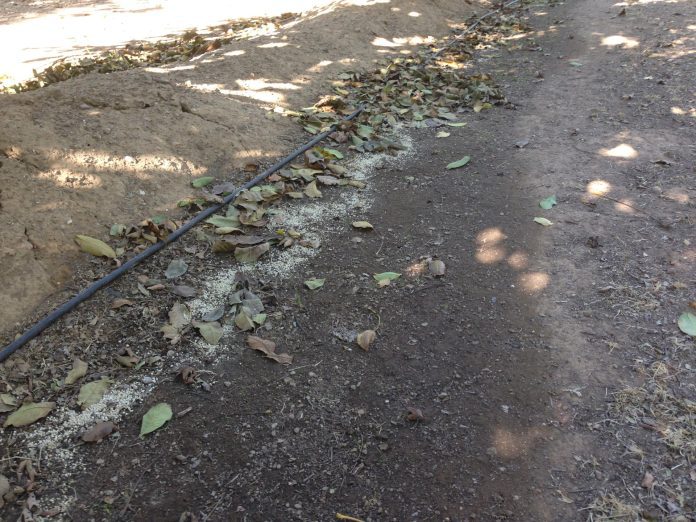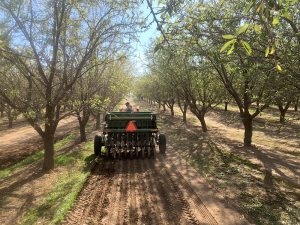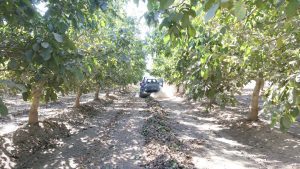
It’s getting toward the time of year for looking both forward and back, reviewing the past crop year for lessons learned while prepping the orchards for winter weather and the 2024 crop. What a year it has been!
Almonds
Irrigation
Adequate postharvest irrigation is critical to good production next year. Yield was reduced 40% the following year due to extreme water stress in a UC study where no irrigation was applied after harvest. Don’t sleep on postharvest irrigation in almonds. Please note: The importance of postharvest irrigation doesn’t mean that preharvest irrigation (bloom to shake) isn’t also critically important, it is. The point is adequate irrigation after harvest is very important to production next year. While the critical times are August through September (more heat = more water use), October is important, too, especially if temperatures stay warm.
The good news is by early October, orchard water use and irrigation need eases as the days shorten and temperatures cool. Still, irrigate to keep the trees at low to moderate stress levels until leaf drop. Low/moderate stress doesn’t drop leaves, stop photosynthesis or reduce storage of energy (carbohydrate) reserves for next spring. Target stem water potential numbers using the pressure chamber and run -12 to -14 bars, roughly -2 to -8 bars below baseline. See the links for pressure chamber use in almonds at the end of this column.
Pests
Worm (navel orangeworm; NOW) damage in Nonpareil (NP) is terrible this year in many orchards and pollinizer numbers could be worse as NOW pressure builds over time. I saw and heard of 15% to 20% damage in Nonpareil field samples. Crop and quality incentive losses at 15% field damage exceed $500/acre for NP in a 2000 meat lbs/acre crop valued at $1.6/lb. Field sampling is critical to understanding just how much damage really occurred. Almond processing (hulling/shelling) reduces reported damage by at least 50% and probably more as air-legs and other processing steps eliminate damaged nuts. Reject sheets make things look better than they really are, which helps with quality but doesn’t provide a clear picture of lost crop.
At this point of the season, there is nothing to do about NOW but look ahead. Assuming that there are more than two mummies per tree in the winter orchard scouting, careful sanitation will be needed in most orchards in this region and is critical to reducing damage next season.
Yes, current almond economics make orchard sanitation (shaking, sweeping, and mowing mummies) expensive. But there are no alternatives to reducing the massive NOW populations in orchards coming out of the summer, especially this year given the damage in many orchards. Swap, trade or barter services or goods to get the mummies out of your trees (or your neighbor’s) before next bud swell. A regional approach where neighbors band together to sanitize orchards and remove ditch almonds and other hosts will further lower NOW pressure going into 2024. There will be no bigger job in almond orchards this fall/winter. Pink bud next February is the cut-off for this activity at least for the first step of shaking/polling.
Talk with your PCA about spur sampling for San Jose scale (SJS) once the leaves come off this fall. High SJS scale populations kill wood and reduce yield. A dormant spray controls scale where needed. Scouting shows if and where this practice is needed.
At the start of natural leaf drop (November?), a high rate (20 lbs/acre) zinc sulfate spray delivers zinc into the trees and, as a bonus, drops rust- or shot hole-infested leaves.
Work out a gopher control plan for later this year when field work slows.
Possible wet winter? Time to think about root health and phytophthora prevention. Make sure there is a clear exit path for runoff water from the orchard and surrounding area with a potentially wet El Nino winter in the forecast. Talk with your PCA about phytophthora management options. Rotating fungicide chemistries is key to managing resistance. See link below for material choices and rankings. See UC IPM fungicide efficacy ratings and resistance management information in the link at the end of the column.
On the subject of winter water…The goal of water management in winter orchards is to maximize infiltration while making sure that the excess runs off completely. Cover crops and/or organic matter (compost, nut shell, etc.) helps soften the impact of rain on the orchard floor and help with infiltration. Better infiltration means improved salt leaching and groundwater recharge. Cover crop planting should be done by November 1. See link to Almond Board info on cover crops.
Nutrition
Where needed, a boron (B) foliar feed is the most important fall fertilizer practice in almond orchards. If hull boron levels are low, applying 2 lbs Solubor/acre (0.4 lbs B/acre) can increase yields by several hundred kernel pounds/acre (this practice doesn’t reduce the need for bees, frost protection, etc. but it improves the results from those investments.) The added B helps with nut set at bloom, so the application must be ahead of bloom in the fall or at pink bud. October is a great time for this foliar treatment. Soil-applied B doesn’t reach spurs ahead of bloom and so doesn’t help with yield for the new crop. Check with your CCA regarding B rates and materials. If a spring/summer zinc foliar spray wasn’t done, consider adding 5 lbs zinc sulfate/acre to the B in early October to improve tree zinc levels. This “low” zinc rate in early October was as effective as 20 lbs zinc sulfate/acre in November in increasing zinc levels in peaches in UC research.
Talk with your CCA about potassium (K) rates and materials. Fall application of field-grade, less expensive SOP (sulfate of potash; potassium sulfate) fertilizer is an effective practice to load the soil w K ahead of the next crop. Almonds use 95 lbs K2O per 1000 lb kernel crop, so use orchard crop history to set the annual rate of K2O/acre. Band or locally broadcast the dry fertilizer to make sure the fertilizer K is in the active root zone next year. In sandy soils where K leaching can remove some concentrated (banded) K, consider a light rate in the fall and fertigate the remaining annual budget K next season. In drip-irrigated blocks, put the fertilizer band near the drip lines where irrigation water reaches to ensure the roots will reach the K. Local broadcasting underneath microsprinklers is becoming an accepted practice. A single band of K fertilizer per tree (only on one side, not both) works fine. Coordinate dry fertilizer application and sweeper work so the blower doesn’t scatter fertilizer.

Almond shell is 1.5% K2O by weight (36 lbs K2O/ton) and can contribute to an annual orchard K budget as well as help with rainwater infiltration and erosion control. See link, below, to info on applying shell.
Unless the summer leaf analysis results show low nitrogen (N) levels (less than 2.4% N), no fertilizer N need be applied before leafout next March. If leaf levels are less than 2.4% N, apply a low rate of soil or foliar applied N to “top up” woody tissue N storage going into the fall. Just 20 lbs N/or similar low rate will do the job as N use is very low this time of year. Once leaf drop has started later this fall, root uptake of soil N is very limited. Make any fall N application when the orchard has a full healthy leaf canopy.

Planning
Sometime this fall, take time to review the 2023 season (reject sheets, leaf analysis results, etc.) with your PCA and CCA. What worked and what didn’t for NOW management? How about nutrition? Where possible, make plans to adjust 2024 practices based on 2023 experience.
With light crops the last two years in the Sac Valley region and the state, the 2024 California almond crop could be in the 3-billion-pound range if bloom weather is good. This could mean no improvement in almond prices and a good-big crop set in many orchards. This will mean significant inputs of potassium and nitrogen to feed a big crop and pesticides to protect that crop. I think it’s better to budget for a big crop as much as possible in this market and go into next year aware of the possible situation.
Walnuts
A few points to remember during harvest and beyond. Fingers crossed for a better crop year than 2022.
Whenever possible, shake, pickup and deliver walnuts on the same day for the best-quality product.
Review summer leaf samples for possible nutrient deficiencies. For fall practices, especially consider K nutrition. Deficient orchards (0.9% leaf K or less) produce less crop than those with adequate (more than 1.2% leaf K) and should receive a banded application of up to 400 lbs potassium sulfate (200 lbs K2O/acre). Walnuts remove 50 lbs K2O per ton of nuts, assuming the whole nut (including hulls) are removed. If the hulls are left in the field, much less K is removed but left in the row middles in the hull tissue.
Postharvest, continue prepping your walnuts for the possibility of a hard freeze later this fall. Key points: Shoot growth should be stopped in September using water cut-off, then restart irrigation to reduce orchard stress. Keep orchard floor vegetation at 2 inches or less starting mid-October. If no/little rain through October, irrigate orchards to keep the soil moist ahead of forecast cold.
Finally, there is interesting information in recent UC walnut newsletters on practices/considerations for growing tomatoes after removing walnuts.
Best wishes to all for a safe and productive harvest.
Resources
Irrigation
UC ANR Pressure chamber use in almonds, walnuts, and prunes (27 pages) anrcatalog.ucanr.edu/Details.aspx?itemNo=8503
Advanced SWP (stem water potential) interpretation in almond.
sacvalleyorchards.com/manuals/stem-water-potential/advanced-swp-interpretation-in-almond/
Pests
UC IPM Navel orangeworm management
ipm.ucanr.edu/agriculture/almond/navel-orangeworm/
UC IPM San Jose scale management
ipm.ucanr.edu/agriculture/almond/san-jose-scale/
Growing the Valley Podcast (UCCE) on gopher management (with links to more information)
growingthevalleypodcast.com/ipm-1/2022/2/24/pocket-gophers-with-roger-baldwin-7d54t
UC IPM Fungicide and Bactericide Efficacy and Timings Publication, 2022
ipm.ucanr.edu/agriculture/ scroll down to “More Information” for the link. See pg 37 for phytophthora materials.
Nutrition
Almond hulls and/or shells are potassium source.
sacvalleyorchards.com/blog/almonds-blog/applying-amendments/
Cover crops
Almond Board of CA Cover Crop Guide
almonds.com/almond-industry/industry-news/questions-about-cover-crops-new-bmps-can-help
Planning
NASS Almond Acreage Report for 2022 (April, 2023 release)
nass.usda.gov/Statistics_by_State/California/Publications/Specialty_and_Other_Releases/Almond/index.php
Walnuts
Protecting walnuts against winter freeze damage
sacvalleyorchards.com/walnuts/horticulture-walnuts/prepare-for-next-sudden-autumn-freeze/
Tomatoes following walnuts:
cesutter.ucanr.edu/news_204522/Sacramento_Valley_Walnut_News_135/















